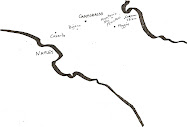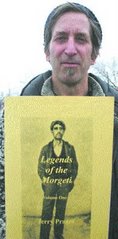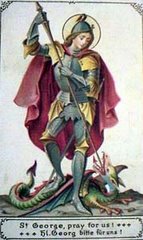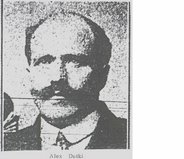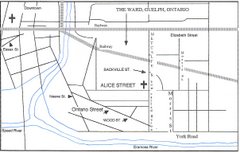The following appears in the book as an appendix.
This is not the Code of San Giorgio Morgeto however, but a Sidernese code found in Toronto. If anyone has a copy of the code of San Giorgio that Italian caribinieri discovered in the home of Giuseppe Mammomliti in Taura Nova in 1963 I'd be happy to receive it. The following is an attempt to understand the references in the code, and to make sense of the allusions. There are certainly strong elements of legend and fable inter-mixed in this. The version I am using here was published in Deadly Silence by Antonio Nicasso and Peter Edwards.
Three Spanish Knights
The story of the three Spanish knights is told in the Code of the Honoured
Society, a handful of which codes have been discovered over the years in
Calabria. This version is one that was discovered in Toronto 1972 in the home
of one of the Siderno Racco family's associates, Francesco Caccomo. As
mentioned earlier, one of the documents found in Calabria is known as the
Code of San Giorgio Morgeti, but a copy is not available.
According to the legend of the brothers as outlined in the Toronto Code, the
three were brothers who feld Spain after killing a nobleman who had
dishonoured their sister. The three self-exiled knights made their way to Italy.
Osso settled in Sicily and is regarded as the founder of the Sicilian Mafia (Cosa
Nostra,) Mastrosso settled in Naples and founded the Neapolitan Camorra, and
Carcagnosso settled in Calabria, where he founded the Picciotteria, precursor to
the Honoured Society, the 'ndrangheta.
The legend says that the three agreed to spend the rest of their lives
defending the weak against the arrogant and the overbearing. According to the
code Carcagnosso organized his Calabrian society in greater detail than did his
brothers and thus he elaborated both an extensive set of rules to govern the
society, and developed a mythopoeic language to describe it, ie. the society is a
flowering garden under a guiding star, governed by a capo bastone, the trunk of
the tree, while its treasurer or contibile represents its bark, its senior members
or camorristi are its branches, the piccioti/soldiers its twigs, and the young men
of honour, the giovanottini d'onore, the flowers.
For several centuries the society of the piccioti functioned in the
desperately poor lands of southern Calabria, operating as the arbiters of civil
society in a province governed by the agents of landlords from elsewhere,
especially after the Spanish Hapsburgs lost the region.
Allegorically Catholic, they declared themselves under the protection of the
archangel Gabriel. The morality of the Honoured Society appears to have more
in common with paganism than with Christianity, for it is culture of vendetta
and curse more rooted in the cult of Persephone as practiced in Morgantina,
than in the cult of Jesus as practised by St. Paul. A picture of the Virgin Mary
is in fact burnt during initiation ceremonies.
The Society's code gives its members 'Humility, Loyalty, Politics, False
Political Power, Paper, the Knife and the Razor'. Their sense of humility is not
spiritual humility but humbleness towards the Society. Likewise 'Loyalty' is to
the Society and not to the community. ' Politics' is the power politics of
Machiavelli, not the ideals of social equality. "False Politics" is the freedom to
lie to everyone but members of the Society.
The 'paper' is for counting money, 'the knife' is for punishment, and the
'razor' for the disfigurement of the Society's enemies. It is interesting to note
65 that the Ellis Island immigration records show that scores of Morgeti had scars
on their faces.
It is clear from the code that for members of the Society, Catholicism's
virtues are ceremonial rather than spiritual, while devotion to the society
governs every action. And so, as the centuries passed the Society kept a low
profile but seems to have taken root to greater and lesser degrees in the
villages, towns and cities of south Calabria. With their particular sense of
ancient rights, the clans of the Morgeti found power in the society.
The society's code ranges from the poetic to the historically explicit, at
least insofar as numerous real people and places are mentioned. For instance
the three Spanish brothers are said to have created their societies on the island
of Faviganna, off the coast of Sicily, where the knights are allegedly buried, "
in an honoured tomb covered with a door of finest white marble". It sounds like
an episode from the Discovery channel or an A&E Ancient Mystery episode.
Mention is also made in the code of the "ancient Duke of Faenza" who
possesses the keys " found at the ends of Spain." Faenza is an Italian city in the
province of Ravenna in the episcopal see of Emilia-Romagna. The Duke is
probably the young man whose people rallied around him when Cesar Borgia,
acting on behalf of his father, Pope Alexander I, was besieging ducal cities as
he moved inland from the Adriatic Coast with his corrupt papal armies. Borgia
forced the cities one by one under Borgia/papal command, breaking the hold of
the Hapsburgs of Spain who still commanded the Kingdom of Two Sicilies.
(Naples and Sicily) The Duke of Faenza stood firm, and so the keys "were not
lost".
The text goes on to say that the keys aren't lost between comrades "because
with a word of humility one forms and with a word of humility one dissolves."
But one key is gold, and the other silver, one to open one to close.
In the early years of Spanish rule in Italy, Amerigo Vespuci sailed from
Seville, and soon after he did, Spain became immersed in pillaged gold and
silver from the New World. There is 'a tower of Gold in Seville', but silver
from the New World also turned Seville into one of the most important cities in
Europe. Not surprisingly North and South America are the source of most of
the Society's gold and silver even today, only now it flows from cocaine sales.
Ravenna, Italy, home of the ancient Duke of Faenza, is where the Medici
fortunes were revived in the 1500's after the Spanish removed the French from
Italy, and destroyed the republic of Florence. Cardinal Giovanni Medici
became Pope Leo X, whom Machiavelli counselled in his book, The Prince.
The Spanish themselves came to be governed by Austrian Hapsburgs after
1516. Three years later the Hapsburg King Charles of Spain was elected
emperor of the Holy Roman Empire and from 1522 on Naples was ruled by a
Spanish viceroy. Which is around the time that the three brothers are said to
have come to Italy.
Whatever the code is talking about, one thing is clear, and that is that Italy,
divided among popes and dukes and kings and emperors and three Spanish
knights, was the spoil of many wars. The people themselves were no more than
cannon fodder for successive conquerors, unless they defended themselves.
By 1707 the Spanish, now themselves governed by the French, lost Naples
to the Austrians. Then they lost Sicily, although they got it back in 1713, after
which it flipped hands for a while until a son of the Spanish king claimed both
66 Sicily and Naples for the French Bourbons in 1738, which was not a happy
time for Italian patriots.
In 1783 southern Calabria was rocked by an earthquake so devastating that
San Giorgio was among the only places still standing. The village became a
"Sacred Case" and the people were allowed access to Church incomes,
properties and even access to the convents.
By Jan. of 1799, southern Italy was being run by the French Republic under
Napoleon Bonaparte. The Spanish court at Palermo Sicily sent a Cardinal to
Calabria to organize resistance and the whole population arose, including
brigands, convicts, soldiers and peasants, who entered Naples after a bloody
battle at the Ponte de Maddalena, after which they drove out the French
republicans and their Italian allies. Carcagnosso's society undoubtedly played a
role in reviving the fortunes of its Neapolitan and Sicilian brethren.
The Bourbon court returned to Naples from Palermo, Sicily in 1802,
although by 1805 they had to flee back to Sicily, after which Joseph Bonaparte
took over Naples, although his rule was contested outside the city by brigands.
The now 'Emperor' Napoleon Bonaparte made Joseph king of Spain after
Joseph was defeated by the British in Calabria.
Joachim Murat who was married to Caroline Bonaparte, was installed as
King of Naples, and filled his administration with Neapolitans, By 1814 he
declared himself separated from Napoleon and when Bonaparte was
incarcerated on Elbe, Murat allied himself to the British. When Napoleon
escaped from Elbe, Murat went back to his old allegiance, but after the
emperor's defeat at Waterloo the Austrians marched into Naples and once more
restored the Bourbons, who again crossed over from Sicily.
And through it all the secret societies fought their own causes for their own
reasons, and carried their various peoples with them.
In the meantime the Bourbon King Ferdinand and his wife had so alienated
the population of Sicily with their extravagance and police spy networks that
the British were able to force Ferdinand to abdicate in favour of his son. The
British also secured the creation of a new constitution for Sicily, although
Ferdinand came back into power in Naples, with the support of the Austrians
who commanded him not to give the Neapolitans a constitutional government.
Murat, making the mistake of thinking he had support in Calabria went
there only to find himself trapped by peasants, court martialed by police and
shot.
Ferdinand Bourbon proclaimed himself King of the Two Sicilys and by
1816 abolished the British-created constitution.
Meanwhile various members of the king's army were secretly being
organized into Carbineri lodges. The carbineri were a freemasonic
revolutionary society committed to forcing the king into granting a
constitutional government. Nobles, army officers, small landlords, government
officials, peasants and priests made up the ranks of the Carbineri.
King Ferdinand created his own secret society to destroy the Carbineri, the
Calderai del Contrappesso, which recruited its members from the brigands and
the lower classes of Naples. He was committed to the destruction of liberalism.
The Carbineri however flourished and spread throughout Italy. Lord Byron
joined their ranks. The Carbineri triggered the Neapolitan revolution of 1820,
which brought constitutional government to Naples and Sicily, although a year
67 later the Austrians marched in and put an end to parliament, leaving Ferdinand
free to hunt down the surviving Carbineri. Which in turn led to a reactionary
pan-European accord that allowed any European power to step in and quell
revolution in any other European nation. Only France and Britain were
uncomfortable with the Austrian-orchestrated accord.
Mastrosso's Camorra in Naples first became publicly known in 1820, when
it rose out of the Neapolitan prisons and struck at Bourbon misrule. The society
was originally a means for released prisoners to protect one another from
patrols, but they quickly turned into street gangs, and then they turned to
smuggling and blackmail, eventually infiltrating the entire social structure of
Naples. The Camorra made their profits from brothels, and from running
protection rackets on Neapolitan merchants.
By 1831 Carbineri revolutions were breaking out all over Italy, but the
Austrian army again suppressed them. The movement, having taking the brunt
of Austrian force, soon dwindled, only to be replaced by the Young Italy
movement of Giuseppe Mazzini. By 1836 independent members of the Young
Italy movement landed in Calabria thinking the population would rise to
support a revolution in support of constitutional reform, but they were captured
and shot instead.
And then came the revolutions of 1848, first in Sicily, then in Naples. The
Camorra became political. After the granting of a constitution in 1860, the
Camorra became all-powerful at elections, but Naples was soon in chaos and
by 1862 repressive measures were being taken to restore order.
At the same time the Carbineri, as constitutional revolutionaries, turned to
assist the Lombards against the Austrians. The Italian unification movement
began to gain momentum, but then parliamentary problems turned into a
reactionary response from the king leading to an end to constitutional
monarchy and the call for the army to return from assisting the Lombards
against Austria.
In Sicily however, the revolutionaries disavowed the court of Naples, and
declared themselves committed to a united Italy. Ferdinand sent an army,
which ravaged the island. With Sicilian freemasonry broken, the society of
Osso was the only game in town. The Bourbon king turned his attention to
Naples, and soon filled the prisons. Future British Prime Minister W.E.
Gladstone, who saw the conditions of the Neapolitan prisons, described them
as "the negation of God erected into a system of government."
The Toronto 'ndrangheta document also has this to say, "...let me know
where the Camorra was discovered.... In 1848 it was discovered. In 1852 they
wished to destroy it. Who was it that wanted to destroy it? Carlo Misiano and
Salvatore Imbalsamo."
Just who those two were I don't know, but the secret societies were, and
remained, defenders of an anti-constitutional movement.
The document also states that "Beautiful humility taught me, with roses and
flowers you covered me; in 1848 a war broke out in Calabria, Sicily, Spain and
the Neapolitan State. The blood lost by the Society was collected in a chalice
of finest silver and brought to Montalbano." The War in Spain in those years
was a civil war fought over succession to the crown.
In 1857, Calabrian peasants, along with local police put down yet another
constitutionalist landing in southern Italy, and only a intervention by Britain
68 saw the release of some of the many political prisoners, who then went into
exile. The Duke of Calabria in those days was the second son of the Bourbon
King, Ferdinand.
In 1859 King Ferdinand died, and his son Francesco II took over, but by
then Garibaldi had begun to wage a long and bitter battle for unification
throughout southern Italy. Garibaldi's small force fought the King's supporters
for nearly two years. By May of 1860, the forces for Italian unity landed in
Sicily. Garibaldi proclaimed the Sardinian king Victor Emmanuel king of all
Italy and a few battles later the Sicilians rallied to his cause. By August he had
landed in Reggio Calabria where he forced Italian unity on the reluctant heirs
of Carcagnossa. Garibaldi was wounded during that conflict.
By September of 1860 Francesco II and his queen sailed out of Naples. The
Sardinian King, Victor Emmanuel, now afraid of Garibaldi's purposes, met him
with a large army two weeks later, but Garibaldi's veteran troops defeated the
king's army. Garibaldi once more proclaimed Victor Emmanuel king of all
Italy, which was later confirmed by plebiscite after Garibaldi went home,
seemingly sick of Italian politics.
Following the establishment of the Sardinian supremacy in 1860, more than
two hundred and sixty arrests were made over the next months among the
Calabrian Picciotteria.
The secret societies rooted as they were in their loyalty to the ideologies of
three Spanish Hapsburg knights, remained outside the middle class and their
unification movement, and remained opposed to Sardinian control of southern
Italy. Historians regard the decades that followed the unification of Italy as a
period in which southern Italy paid for its opposition by paying off Sardinian
war debts.
King Victor Emmanuel renamed the village of San Giorgio, San Giorgio
Morgeto in 1864, to reconnect the village with its ancestry. Perhaps it was an
effort to make peace with its citizens. When the exiled Francesco died, his
brother Alphonso, still calling himself the Duke of Calabria, became King in
exile. There is a Bourbon Duke of Calabria alive in 2006. Those first thirty
years of Sardinian occupation of southern Italy were bitter ones.
On March 30 1911 while another Camorra trial was being held in Italy, the
Globe contained an editorial that began:
"For a variety of reasons, mainly political and historical,
Italy has been honeycombed with secret societies. Among
these the most notable have been the Carbonari, the Mafia
and the Camorra. They have to an extent a common origin:
the lawless condition of Italy during the middle ages,
which was perpetuated into modern times by the
subdivision of the country into Petty States - some under
independent rulers, some under the temporal jurisdiction of
the Papacy, some comprised in the Bourbon Kingdom of
the Two Sicilies, and some under Austrian rule through
military subjugation."
The editor goes on to say that unity would not have been accomplished
without the 'adroit and effective use of the societies" by political leaders. The
column continues by suggesting that the Carbineri, which had
69 "degenerated into an association of assassins, was by
Mazzini, who became a member of it, elevated into a
society with 'liberty, equality and humanity' for its motto
and the term 'assassination' was erased from its statutes.
The Carbonari had Northern Italy for its field of operations:
the mafia and Camorra were mostly confined to Naples and
Sicily."
Later the editorial notes that
"The municipal administration of Naples became so
scandalous under their sinister influence and operations
that the constitution of the city was suspended a dozen
years ago by the Italian Government, and a Royal
Commission was appointed to investigate the operation of
the Camorra."
On July 21 The Globe was reporting that the Camorra trial had degenerated
into "a violent scene" in which "in the tumult the lawyers fled the room" and
that "President Bianchi, helpless to maintain order, declared the session
adjourned."
While the Globe focused on the Camorra and Mafia in that editorial, they
were clearly aware of the Picciotteria in others.
The Honoured Society's ceremonial document concludes with the statement
that "A great swearing (occurred) which included the Knight of Russia and
Duke of Abruzzi who legally made of it (the society) their sister." Fiorentino of
Spain was also present, in fact he was in charge of the ceremony for the two
new arrivals into the Society.
The Duke of Abruzzi (1873-1933) was an Italian vice-admiral and explorer,
born Luigi Amadeo di Savoie at Madrid. He was the son of the Spanish King
Amadeus who abdicated his throne soon after Luigi was born and who became
the Duke of Aosta in Italy. Luigi was also a cousin of the Sardinian king of
Italy, Victor Emmanuel III.
Luigi Amadeo had a distinguished naval career, was a world traveller, and
mountaineer, with several climbed firsts to his name. He published a book
called The Climbing of Mount Elias, a peak in Alaska, which he was the first
to climb.
In WWI he commanded the Italian naval forces in the Adriatic. Later, in
the 1920's he carried out an Italian colonization scheme of Somaliland. It
seems significant however that the deed for which he is most remembered was
evacuating 100,000 Yugoslav refugees from Albania in 1916.
Who the Russian Knight might have been who took part in the ceremony
with the Duke of Abruzzi isn't clear, but the relationship between modern
Italian organized crime, Serbian crime groups and Russian mobsters is very
clear to modern mob watchers. Toronto mobster Paul Volpe had a brother
named Albert who ran casinos in Yugoslavia in the mid-1960's and again in the
1970's, and, according to James Dubro in Mob Rule, Albert was attempting to
get one going again in the mid-1980's.
In 2002, a conference held in London, England noted that pressure on Italian
mobsters had led them to form strong financial ties with the Russians, to the
point that Moscow was being called the "New Palermo." Both groups were
using the relationship to strengthen one another.
70 The connection between Italian crime groups, Spanish-speaking drug cartels
from South America and Russian and Serbian gangsters has a ritualistic unity
to it that is best accounted for through the evolving ceremonies of the
'ndrangheta.
While the ritual that brought the Russian Knight and the Duke of Abruzzi to
the society's protection refers to the high mountains of Spain where the family
of Montalbano and Fiorentino lives, the name Montalbano doesn't appear in
lists of Spanish mountains. Montalbano however does happen to be the name
of the ridge near Florence Italy, home of the Florentines. Which would suggest
that the meeting at which the Duke of Abruzzi and the Russian Knight made
the Society its sister may have occurred on the ridge of Montalbano and was
attended by someone representing Florence, the 'Fiorentino'. Curiously,
Veroni/Varone was originally a Florentine clan name.
What do you get when a deconstructionist joins the mafia ?
An offer you can't understand.
Wednesday, May 30, 2007
Subscribe to:
Comments (Atom)
